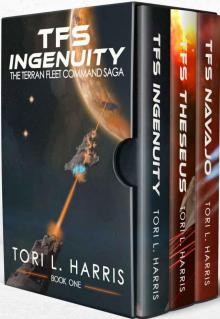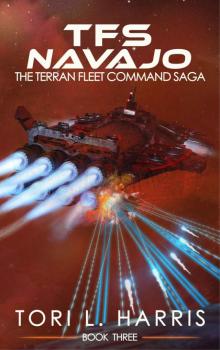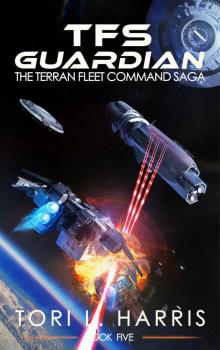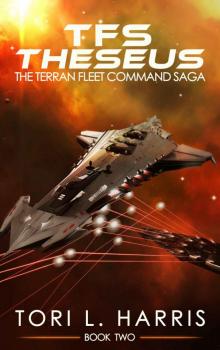- Home
- Tori Harris
TFS Theseus: The Terran Fleet Command Saga – Book 2
TFS Theseus: The Terran Fleet Command Saga – Book 2 Read online
TFS THESEUS
The Terran Fleet Command Saga – Book 2
*****
Tori L. Harris
ISBN: 978-0-9961796-3-8
TFS THESEUS
THE TERRAN FLEET COMMAND SAGA – BOOK 2
VERSION 1.0
Copyright © 2016 by Tori L. Harris
All rights reserved. This eBook is licensed for the personal enjoyment of the original purchaser only. Thank you for respecting the hard work of this author. No part of this book may be reproduced or transmitted in any form or by any means, electronic or mechanical, including photocopying, recording, or by any information storage and retrieval system without the written permission of the author, except where permitted by law.
This is a work of fiction. The characters and events portrayed in this book are products of the author’s imagination or are used fictitiously. Any similarities to real persons, events, places, or organizations are purely coincidental and not intended by the author. Any references to actual places, people, brands, or other works of fiction are also fictitious.
Written and Published by Tori L. Harris
AuthorToriHarris.com
Edited by Monique Happy
www.moniquehappy.com
Table of Contents
Chapter 1
Chapter 2
Chapter 3
Chapter 4
Chapter 5
Chapter 6
Chapter 7
Chapter 8
Chapter 9
Chapter 10
Chapter 11
Chapter 12
Chapter 13
Chapter 14
Chapter 15
Chapter 16
Chapter 17
Chapter 18
Chapter 19
Chapter 20
There are no great men, just great challenges which ordinary men, out of necessity, are forced by circumstances to meet.
Fleet Admiral William Frederick “Bull” Halsey, Jr.
Chapter 1
TFS Navajo, Earth Orbit
(Combat Information Center)
Vice Admiral Kevin Patterson, Chief of Naval Operations, stared intently at one of the large view screens lining one side of TFS Navajo’s Combat Information Center. Rather than a simple live feed from a single source, the image represented the combined inputs from a dizzying array of sensor types, all focused on a single target and seamlessly presented in real-time by the flagship’s AI.
“Bridge, Gun-shy,” Patterson announced, using the call sign he had earned for himself years ago due to an unfortunate incident at the firing range.
“Gun-shy, Navajo-Actual. Go ahead, Admiral,” came the immediate response from Flag Captain Ogima Davis, who had just hustled back to the bridge from his quarters after finally getting an opportunity for some much needed sleep.
“If the AI’s projection is correct, our friend out there is coming straight at us. Go ahead and break orbit and attempt an intercept. I’m not sure how much difference it will make, but if we need to maneuver, I’d prefer to be out of Earth’s gravity well.”
“Understood, Admiral.”
“Nice and slow, Captain Davis. I’d like to give the impression we are coming out to greet an old friend, not confront an intruder. Gun-shy out.”
Within seconds, the ever-present background rumbling noise in the CIC increased slightly as Navajo’s colossal sublight engines throttled up to begin pushing the mammoth, nine-hundred-fifty-meter-long heavy cruiser out of Earth orbit. Powerful Cannae thrusters mounted with varying orientations throughout the Navajo’s hull allowed her to execute a gentle, banking turn in the direction of the approaching Pelaran ship with an easy grace that seemed to contradict her tremendous size. Watching an external video feed of the maneuver, Admiral Patterson couldn’t help pausing to stare for a moment. Though she was nearly double the length of the largest ocean-going vessel ever built, Navajo executed the maneuver with much of the same nimble agility possessed by the much smaller Ingenuity-class frigates.
“I need an Emergency Action Message for immediate fleet-wide distribution,” Patterson announced without turning to look in the direction of the nearest Communications console in the CIC. Hearing no response, he wheeled around to face the young ensign, who appeared to be transfixed by the drama playing out on the various screens as if it were a particularly interesting cable news feed. “Ensign!” he bellowed, uncharacteristically raising his voice.
Ensign Katy Fletcher jumped involuntarily, her normally fair complexion flushing bright red as she realized the admiral had actually been speaking to her. “Yes, Admiral Patterson, sorry sir.”
The CNO raised a bushy eyebrow and regarded the young ensign momentarily. In spite of his irritation and the urgency of the current situation, a distant part of his mind quickly recalled a long list of similar transgressions committed by a young, particularly thickheaded ensign once known as simply “K.P.” The old admiral stifled a chuckle and shook his head to let Fletcher know that she should consider herself duly chastised. “It’s alright this time, Fletcher. If a sight like that doesn’t make you want to stop and stare, I think TFC may not be the right line of work for you.”
“Hooyah, sir!”
“Hooyah indeed. Now, let’s get to work, shall we?”
With the enthusiastic help of a now fully alert Ensign Fletcher, Patterson took just over a minute to compose and transmit the following Emergency Action Message:
Z2129
TOP SECRET - MAGI PRIME
FM: CNO ABOARD TFC FLAGSHIP, TFS NAVAJO
TO: EAM — FOR IMMEDIATE TFC FLEET-WIDE DISTRIBUTION
INFO: PELARAN GUARDIAN SPACECRAFT APPROACHING EARTH
1. SPACECRAFT BELIEVED TO BE PELARAN GUARDIAN APPROACHING ON-ORBIT TFC FLEET ASSETS.
2. IMPERATIVE THAT SHIPS AND ORBITAL FACILITIES TAKE NO PROVOCATIVE ACTIONS WHATSOEVER.
3. SET STATUS OF ALL CIVILIAN SPACEFLIGHT OPERATIONS TO ‘TERMINATE UNTIL FURTHER NOTICE.’
4. TFC ASSETS — HOLD ALL LAUNCHES AND ON-ORBIT FLIGHT OPERATIONS UNTIL DIRECTED BY FLAG.
5. ASSUME ALL TRANSMISSIONS MONITORED BY GUARDIAN SPACECRAFT. ADM PATTERSON SENDS.
TFS Ingenuity, Approaching Earth Orbit
(8.5x104 km from Earth)
Captain Tom Prescott trudged aft towards Ingenuity’s Flight Deck for the short shuttle ride over to Admiral Patterson’s flagship feeling like a man on the way to the gallows. Less than twenty-four hours earlier, he had taken his ship into battle despite explicit orders to avoid hostile forces altogether — orders issued by Duke Sexton, Commander in Chief, Terran Fleet Command, immediately before his ship’s departure. Although his frigate’s participation in the battle had not been entirely by choice, Prescott couldn’t help but wonder if the admiral would view the situation in the same light.
The “Battle of Gliese 667,” as everyone now seemed to be calling it, had been against two ships possessed of vastly superior firepower to his own that had been illegally commandeered from the Sajeth Collective — a seven-world alliance already teetering on open hostilities against Humanity. Although the Collective had officially initiated diplomatic relations with Earth via Ambassador Nenir Turlaka, she had been obliged to deliver potentially catastrophic news as one of her first duties upon arriving in the Sol system. Powerful political and military officials, in open defiance of the Sajeth Collective’s Governing Council, had plotted to form a splinter group known as the Pelaran Resistance. Their stated goal was simple: Humankind could not be allowed to achieve military dominance in this region of the galaxy as a cultivated pawn of the powerful Pelaran Alliance.
Leaders of the Resista
nce movement had asserted for some time that the Pelaran Alliance had repeated a pattern of “conquest by proxy” countless times across a vast region of space stretching many thousands (if not tens of thousands) of light years. Through an apparently elaborate process, the Pelarans chose single civilizations — in this case the Humans — within a region of space to rapidly advance within a relatively short period of time. Once this process began, the Pelarans invariably continued to provide their proxies with technological and military assistance until such time that no other civilizations within a five-hundred-light-year cultivation radius could stand against them. All other worlds within this sphere of influence were then left with a simple choice of either subjugation or destruction. Given such a bleak outlook, it was easy to understand why so many within the Sajeth Collective sympathized with the Resistance. Unwilling to accept the will of either the Pelaran Alliance or their unwitting proxy, the Resistance offered another option — a preemptive military strike against the Earth in a last ditch effort to halt Humanity’s progress before it was too late.
As if the current military and political situation wasn’t bad enough, Captain Prescott’s (albeit successful) battle with the Resistance ships had led to his allowing Admiral Rugali Naftur, a highly placed military commander from the Sajeth Collective, to come aboard his ship for the short trip back to the Sol system. At the time, Prescott had felt fully justified in doing so since Naftur believed that he might be able to prevent the attack on Earth altogether if the Resistance forces could be located. Although he fully realized that it might be the height of naiveté, Prescott took the Wek officer at his word. It had, after all, been Admiral Naftur’s ship, the Gresav, that had ultimately destroyed the more powerful of the two Resistance ships, almost certainly saving the lives of everyone aboard Ingenuity.
In any event, Admiral Naftur, his entire crew, and no doubt the Gresav’s sophisticated AI systems, had witnessed Ingenuity’s remarkable (and highly classified) capabilities in battle firsthand. At this point, Prescott doubted there had been much additional harm in allowing the Wek admiral to return to Earth as their guest.
What was it Commander Reynolds had said? Prescott mused. “In for a penny, in for a pound?” I suppose it’s too late to worry much about it at this point anyway. Patterson will either agree with my actions, or throw me in the brig for gross dereliction of duty. Too many more days like today and that may start sounding like a pretty good deal anyway.
As Prescott reached the end of the corridor, he was surprised to hear the ship’s synthetic voice make the all-too-familiar announcement, “Captain Prescott to the bridge!” He noted the urgency in the AI’s announcement, which was designed to convey a tone appropriate for the situation. He found it a little difficult to believe that some new emergency had arisen in the sixty seconds since he had left the bridge, but if the past few weeks had taught him anything, it was to expect the unexpected aboard a starship. Still, rather than immediately heading back to the bridge and further delaying his inevitable unpleasant visit with the admiral, he elected to use the ship’s comlink.
“Bridge, go for Prescott,” he said aloud. Standing alone in the starboard command section corridor, he fought back the natural urge to stare at the ceiling for no apparent reason while speaking. It took the ship’s AI only a fraction of a second to recognize the captain’s desire to communicate with the bridge and route his call accordingly.
“Reynolds here, Captain. Sorry for the interruption,” his XO responded, “but Admiral Patterson just terminated all flight ops. You’re needed back up here immediately, sir.”
“On my way. Prescott out.” Spinning on his heels and heading back to the bridge of his ship, he couldn’t help feeling a small sense of … What was it? ... Relief? That was probably overstating things a bit, but perhaps the delay would offer at least a temporary reprieve and some time for his actions to be overshadowed by the latest crisis of the day.
***
Inasmuch as such a thing was even possible for four heavily armed Remotely Piloted Space Vehicles, the flight of Hunters discontinued all active sensor transmissions and assumed a nonthreatening, defensive posture. The RPSVs, which were currently being controlled by the AI of the nearby cruiser, TFS Shawnee, established a loose escort formation well aft of the Guardian spacecraft and made no attempt to obstruct its flightpath towards Earth.
The obvious question was what, if anything, Terran Fleet Command should do in response to the ship’s arrival. It wasn’t as if the question had never been considered before. In fact, Admiral Patterson’s staff had recently prepared a number of command briefings — issuing them as mandatory reading for TFC personnel at all levels — covering precisely this topic. The briefings offered a set of general guidelines (very general, it turned out) describing how Fleet expected to handle the appearance of alien spacecraft (particularly Sajeth Collective vessels or the elusive Pelaran Guardian itself). While documentation of this type made perfect sense to staff officers sitting around their admiral’s conference room table, in practice, there were far too many variables to consider. One could argue, for example, that it made perfect sense to intercept Sajeth Collective vessels as far from Earth as possible and regard them as hostile until proven otherwise. Did the same apply to the Guardian spacecraft, or should adopting such an aggressive stance in that case be regarded as unnecessary, futile, and potentially dangerous? The Pelarans, after all, had provided Humanity with a tremendous technological bounty — seemingly out of nothing more than a spirit of interstellar goodwill and cooperation (as the more idealistic members of the TFC Leadership Council were fond of pointing out). From a more practical standpoint, did we even have much of a choice in the matter? Based on all of the intelligence Fleet had managed to gather so far regarding the Guardian spacecraft’s capabilities, and there was still precious little of it, Earth’s nascent, space-based military forces could offer little if any resistance if it chose to attack. That being the case, was it reasonable to run the risk of a military confrontation just for the sake of enforcing what we considered our territorial boundaries? For the moment, Admiral Patterson thought not. Accordingly, all of TFC’s warships in the vicinity — now nearly thirty in number — stood idly by and allowed the GCS to approach Humanity’s homeworld as if it were an expected diplomatic vessel from our most trusted ally.
For its part, the Guardian proceeded in the general direction of the Navajo at a pace that did not give the impression of any hostile intent. Once it detected that the Terran vessels had discontinued their use of active sensors and targeting systems, it immediately reconfigured its own emissions, eliminating those that might appear threatening … at least those it believed the Humans were likely capable of detecting.
TFS Navajo
(Combat Information Center)
Aboard the flagship, Admiral Patterson had once again shifted his attention to the holographic table near the center of the CIC. “Any response, Ensign Fletcher?” he asked for the fourth time in the past ten minutes.
“Nothing yet, Admiral,” she reported, working very hard to ensure that there was zero delay in her responses. “I just tried a laser comlink as well. I think we’ve tried just about everything short of breaking out the Aldis lamps, sir. It has to be ignoring us intentionally.”
“I think that’s probably a valid assumption at this point. Thank you, Ensign.”
Patterson removed his glasses and rubbed his eyes momentarily, then stared once again at the holographic table display while wondering exactly what he was missing, just as commanders at all levels had wondered throughout history. Well, there’s the situation laid out for me with a ridiculous level of detail, he thought. If Admiral Spruance would have had this kind of visibility before the Battle of Midway, I guess he wouldn’t have had much of an excuse if things had gone to hell on his watch. He paused and noted the AI’s projected path of the Guardian spacecraft. Then again, the Yamato and the rest of the Japanese ships didn’t have him outgunned a hundred to one.
Resignin
g himself to the fact that there was nothing further for him to do at the moment, the admiral grabbed a tablet and took a seat at one of the Command consoles near the center of the CIC. He had noticed just before the Guardian’s arrival that TFS Ingenuity’s AI had transmitted its after action report, and this was as good a time as any to take a look.
Before the advent of ultra-sophisticated artificial intelligence systems aboard naval vessels, it had long been the duty of ships’ captains to complete a detailed report of their activities upon returning to port. While this was still the case to a degree, any report the captain chose to submit was now supplemented, and to a large degree replaced, by a standard mission log generated by the cold, unblinking eye of the vessel’s AI. On the plus side, the admiralty was provided with an unvarnished, objective account of everything that had transpired onboard. In addition, the captain was relieved of the administrative nightmare required to sufficiently describe the details of a starship’s mission. On the other hand, there was no longer much of an opportunity for a captain to “spin” his way out of a tongue lashing (or worse) with a skilled turn of phrase in his written report. Privacy truly was a thing of the past in modern society, but this was particularly true aboard TFC vessels. The AI-produced report was arranged in a hierarchical style, allowing the reader to “drill down” to the minutest details, when required. Interested in comparing the number of times a specific weapon system was discharged with another? It’s in the report. Reactor power output and efficiency? It’s in the report. The meal choices made by an engineer’s mate during dinner last Tuesday, including the … results of that dinner on his digestive system? It’s in the report — and with a level of scatological detail that would have caused even the young man’s personal physician to wrinkle his nose in disgust.
It took Admiral Patterson only a few moments of reading to realize that the already dangerously unpredictable situation had just gotten significantly more complex. He felt the hair on the back of his neck stand on end as he realized the implications of the Guardian gaining access to Ingenuity’s mission report, particularly the details regarding Human interactions with members of the Sajeth Collective and the presence of Admiral Naftur aboard Ingenuity at this very moment. Patterson checked his progress momentarily and reread the previous section after noticing that Naftur was not only aboard, but currently sitting on the ship’s bridge at a Command console. Really, Prescott? Filing that tidbit away for later, he quickly checked the document’s transmission time index and cross-referenced it with the GCS’ arrival — or at least when the RPSV flight had detected its arrival. There were roughly ten minutes separating the two time stamps, so it was at least possible that the information had not been intercepted. In reality, Fleet had no way of knowing if their secure communications channels had been compromised by the Guardian spacecraft, but the Science and Engineering Directorate steadfastly insisted that their standard encryption algorithms were all but unbreakable. Being a student of history, however, Patterson knew better than to take such assertions at face value. Based on the data the Sajeth Collective had provided thus far, it seemed prudent to assume that anything transmitted in the presence of the Guardian was no longer private.

 The Terran Fleet Command Saga BoxSet
The Terran Fleet Command Saga BoxSet TFS Ingenuity: The Terran Fleet Command Saga – Book 1
TFS Ingenuity: The Terran Fleet Command Saga – Book 1 TFS Navajo: The Terran Fleet Command Saga – Book 3
TFS Navajo: The Terran Fleet Command Saga – Book 3 TFS Guardian: The Terran Fleet Command Saga – Book 5
TFS Guardian: The Terran Fleet Command Saga – Book 5 TFS Theseus: The Terran Fleet Command Saga – Book 2
TFS Theseus: The Terran Fleet Command Saga – Book 2